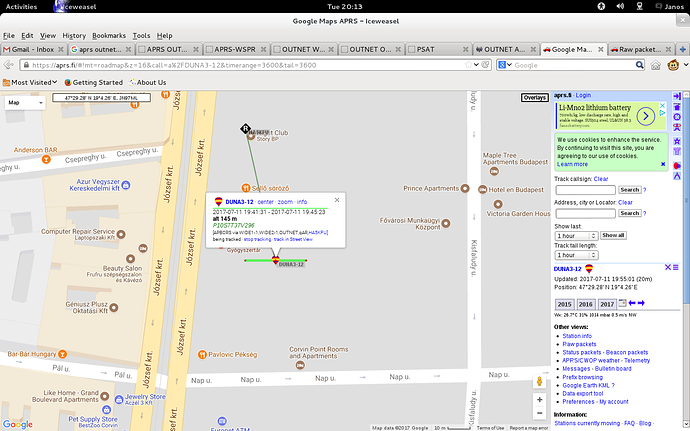In emergency situation it would be practically important to trace an object carriing an aprs tracker somewhere, and send telemetry data to the aprs network. To receive this data possible with the outernet downlink where arenot aprs network or any other possibilities to receive this type of data.
Based on our “floating buoy on Danube” project, I made a small experiment to route some telemetry packets through the outernet network to my Dreamcatcher receiver.
In our experiment we use reprogrammed Vaisala meteo sonde as balloon/aprs tracker. We put this devices in a waterproof box, and it is floating on the Danube river. It functioning as a ready-to-fly balloon tracker as-well.
Here are some info and pictures about our buoy project:
It use the standard radio amateur 432 MHz aprs frequency, and another 430 Mhz frequency for rtty telemetry in balloon/ukhas format.
We havenot aprs iGate-s on this frequency nearby the riverside, so, to our experiments we build “mobile” receivers/igate" units to follow the floating object. One is based on rtl-sdr and RPi2, another is running on laptop for use in car. This units use 3G gsm network to send the data to the aprs network, but, ofcourse possible to use another radio amateur channels to send the telemetry data. Bob Bruninga described the most advanced mode with WSPR, but it can be used the HF aprs network too.
Now in a small experiment I pushed 9 aprs telemetry packet to the aprs network with one of our “mobile” igate setup addressed the packets to OUTNET.
In the last data block, started with /P there ara some minimal sensor data: P = packet counter, S = numbers of gps sat, receoived by the tracker unit, T = temp of the controller unit, V = the Voltage level on battery.
In this experiment the unit didnot floating, the GPS coordinates didnot changed. In our real experiment our buoy unit was floating 15 km on the river, and it has a small hole on tha cover box: went into some water, and stopped the electronics to working…
The numbers of the injected packets are, in this order:
/P4, 6, 8, 10, 12, 14, 16, 18, 20.
The numbers, what received by my Dreamcatcher were:
20, 18, 16, 8, 10
It need more investigations, where the packets lost.
Here are some sample of the injected packets:
2017-07-11 19:41:31 CEST: DUNA3-12>APBCRS,WIDE1-1,WIDE2-1,OUTNET,qAR,HA5KFU:!4729.28N/01904.26EO/A=000482/P6S8T37V297
2017-07-11 19:43:27 CEST: DUNA3-12>APBCRS,WIDE1-1,WIDE2-1,OUTNET,qAR,HA5KFU:!4729.28N/01904.26EO/A=000488/P8S8T37V297
2017-07-11 19:45:23 CEST: DUNA3-12>APBCRS,WIDE1-1,WIDE2-1,OUTNET,qAR,HA5KFU:!4729.28N/01904.26EO/A=000475/P10S7T37V296
2017-07-11 19:47:18 CEST: DUNA3-12>APBCRS,WIDE1-1,WIDE2-1,OUTNET,qAR,HA5KFU:!4729.28N/01904.27EO/A=000472/P12S7T37V295
2017-07-11 19:49:14 CEST: DUNA3-12>APBCRS,WIDE1-1,WIDE2-1,OUTNET,qAR,HA5KFU:!4729.28N/01904.26EO/A=000455/P14S9T37V294
t.janos
